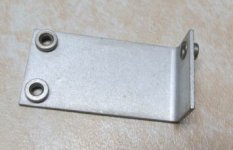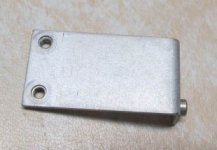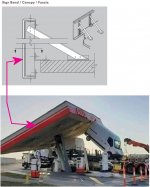I would like to see that if you can find the link. I had a quick look at the chipamp gallery thread, but did not see what you are referring to.Can´t find it now, but I remember (was it in the chipamp section?) that some diyers showed very creative chassis and cabinets made out of aluminum panels and extrusions.
Some had very industrial/futuristic looks.
Yes, this does sound like a way forward for me too.
I hadn't even thought of using angles.
Thanks for mentioning it.
I hadn't even thought of using angles.
Thanks for mentioning it.
One of the neat fasteners -- and a type of these were used by Hewlett Packard (now Keysight) were PEM nuts. RivNuts seem even easier to use: How to Install Rivet Nuts, Nutserts, Rivnuts - Street Beast '66 427 Cobra Replica Hood Catch - YouTube
I make guitar amplifiers since 1969.
Always hated premade iron chassis, it´s difficult to make good holes in them with home shop tools, filing is slow, sharp edges cut your fingers so must be ground down which looks ugly, exposed metal rusts, etc. so from the very beginning used DIY aluminum chassis.
Carried aluminum sheets to shops fabricating tin sheet stuff, such as chimneys, gutters, farm feeding tanks and trays, air conditioning ducts, etc. , who have shears and folding presses, who would cut rectangles and bend them into U shaped chassis, relatively easy to drill/saw/punch at home.
Then could combine them into more complex shapes using Pop rivets or screws.
At a certain moment I standardized on just two drill sizes: 4mm for screw holes (1/8" screws and 3.5mm rivets) and TO3 transistor or tube socket mounting holes, plus 10mm for jacks, pots, switches, Neon pilot lights and 3/4" punched with a Greenlee screw punch for chassis type Fuse holders and Noval sockets.
Could churn out a lot of very usable aand good looking chassis in a very short time.
Aluinum can be brushed with brass bristle brushes for a nice satin finish with no need for paint OR painted with good quality Rustoleum type spray paints, but first requires a primer, or dried paint easily chips off.
And how did I get the metal fabricator´s attention with my small orders?
I was a pesky 16 y.o. nerdy guy, I knew I was not a Customer but a Nuisance, so every day I left some aluminum to be cut-bent I "forgot" on the shop floor a couple "longnecks": fine wine they didn´t usually drink, if at all.
After the first time, I was *always* welcome 🙂
Guess you would use a sixpack for the same result. 🙂
Always hated premade iron chassis, it´s difficult to make good holes in them with home shop tools, filing is slow, sharp edges cut your fingers so must be ground down which looks ugly, exposed metal rusts, etc. so from the very beginning used DIY aluminum chassis.
Carried aluminum sheets to shops fabricating tin sheet stuff, such as chimneys, gutters, farm feeding tanks and trays, air conditioning ducts, etc. , who have shears and folding presses, who would cut rectangles and bend them into U shaped chassis, relatively easy to drill/saw/punch at home.
Then could combine them into more complex shapes using Pop rivets or screws.
At a certain moment I standardized on just two drill sizes: 4mm for screw holes (1/8" screws and 3.5mm rivets) and TO3 transistor or tube socket mounting holes, plus 10mm for jacks, pots, switches, Neon pilot lights and 3/4" punched with a Greenlee screw punch for chassis type Fuse holders and Noval sockets.
Could churn out a lot of very usable aand good looking chassis in a very short time.
Aluinum can be brushed with brass bristle brushes for a nice satin finish with no need for paint OR painted with good quality Rustoleum type spray paints, but first requires a primer, or dried paint easily chips off.
And how did I get the metal fabricator´s attention with my small orders?
I was a pesky 16 y.o. nerdy guy, I knew I was not a Customer but a Nuisance, so every day I left some aluminum to be cut-bent I "forgot" on the shop floor a couple "longnecks": fine wine they didn´t usually drink, if at all.
After the first time, I was *always* welcome 🙂
Guess you would use a sixpack for the same result. 🙂
Just wondered if anybody had tried this stuff, I actually bought it by mistake thinking it to be solid metal. In fact it's a composite sandwich. I used it as a top plate for a valve amp and it's easy to drill and cut. I got thinking it might be useful for making cases. It's very easy to fold if cut on one side with an angle grinder, use standard width disc to gouge out metal and filling, then fold to 90 degree, then reinforce the angle with glue or right angle strip. Truth is I haven't used it to make an enclosure yet, I've just experimented with the folding, works out quite neat. Downside is the colour and it's difficult to paint and it might not be suitable for larger, heavier jobs.. https://ie.rs-online.com/web/p/metal-sheets/7781703
Interesting material.
Not sure what the original purpose was and how edges would look after cutting, but hey, you tell us 🙂
I´d love to see some suggestions and a "how-to" from manufacturers.
Not sure what the original purpose was and how edges would look after cutting, but hey, you tell us 🙂
I´d love to see some suggestions and a "how-to" from manufacturers.
Am I reading that wrong?
How is it a 'solid metal sheet?'
when it is:
"two layers of aluminium filled with a polyester composite"
How is it a 'solid metal sheet?'
when it is:
"two layers of aluminium filled with a polyester composite"
Thats just fibreglass sandwiched between two thin sheets of aluminum (.5mm). To bend, you would score the the one side, ideally with a milling machine to cut a "v" shaped channel, then fold. The most common use is exterior cladding for buildings.
Thanks,I was more wondering about the name of the item.
It isn't a 'solid metal sheet' is it?
It looks interesting for sure though.
I can see why soundoutlad bought it erroneously.
It isn't a 'solid metal sheet' is it?
It looks interesting for sure though.
I can see why soundoutlad bought it erroneously.
The name is deceiving. It is not solid metal. The sheet itself could be considered solid as it doesn't have any air gaps between layers, must be a translation thing.
Thats just fibreglass sandwiched between two thin sheets of aluminum (.5mm). To bend, you would score the the one side, ideally with a milling machine to cut a "v" shaped channel, then fold. The most common use is exterior cladding for buildings.
Not fiberglass, polyethylene, if it had been fiberglass then Grenfell Tower wouldn't have burned as enthusiastically as it did.
Take the part number, hunt-for and shift over to the US site. The listing is a little different.
RS PRO | Yellow Aluminium Sheet, 600mm Long, 3.5kg/m2, 600mm x 3mm | 778-1703 | RS Components
Says in text:
Composite Sheets
Aluminium skins with a polyester composite filling
BUT magnifying the fine print in the image does say "polyethlene" which is a variant spelling for polyethylene.
"Fiberglass" can be epoxy or polyester resin; the ester is much cheaper (and nastier). Nowhere does it say fiberglass.
Burn it. Polyethylene burns like bad wax and mildly toxic. Polyester stinks and can be quite toxic. Cured epoxy is hard to ignite. If there is "hair" in the residue that would be glass fiber.
RS PRO | Yellow Aluminium Sheet, 600mm Long, 3.5kg/m2, 600mm x 3mm | 778-1703 | RS Components
Says in text:
Composite Sheets
Aluminium skins with a polyester composite filling
BUT magnifying the fine print in the image does say "polyethlene" which is a variant spelling for polyethylene.
"Fiberglass" can be epoxy or polyester resin; the ester is much cheaper (and nastier). Nowhere does it say fiberglass.
Burn it. Polyethylene burns like bad wax and mildly toxic. Polyester stinks and can be quite toxic. Cured epoxy is hard to ignite. If there is "hair" in the residue that would be glass fiber.
Some time back I did subject this to "official fire testing" i.e. I took a blow torch to it. The aluminum shriveled as it melted, the filling generated smoke but didn't burn. Don't remember seeing fibers, maybe I can find that piece I scorched.
The aluminum sandwich cladding of the Grenfell Tower was one of the reasons for the long period of time before which the blaze could be extinguieshed.
PS -- it's Fiberglas -- trademarked almost 50 years ago.
PS -- it's Fiberglas -- trademarked almost 50 years ago.
Not impossible, but I wouldn´t expect fibers there, structural rigidity comes from the thin sheet metal *outside* , increasing its moment of inertia by the separation.
It was the foam insulation installed behind the cladding that burned with so much smoke, in the case of the Grenfell Tower. It wasn't the cladding itself that burned so fast, rather it was the fact that it was installed with a gap, creating a chimney for the heat to increase and spread in.
Interesting material.
Not sure what the original purpose was...
That sounds like DiBond, or one of the spin-offs.
It was made to be an architectural cladding for exterior use. Think of the canopies of gas stations and their colorful appearance.
I wouldn’t use it for an amp case, as the .010” aluminum just doesn’t amount to much for durability, or for attaching anything. If you kerf one side so it will bend easier, you’ll have next to nothing left!
It generally works ok when the edges, all of them, are constrained by another means. That would be a tight groove. It will bend but the radii is limited, but with the addition of slots for ventilation, I wouldn’t expect a great result.
https://www.curbellplastics.com/Res...Technical-Resources/Dibond-Fabrication-Manual
That sounds like DiBond, or one of the spin-offs....
DIBOND(R) | The original aluminium composite panels
What Are Dibond Signs?
https://www.curbellplastics.com/Res...rces/Technical-Resources/DIBOND-Product-Sheet
> Think of the canopies of gas stations and their colorful appearance.
Attachments
Last edited:
- Home
- Design & Build
- Construction Tips
- Tips for building simple ALU cases


